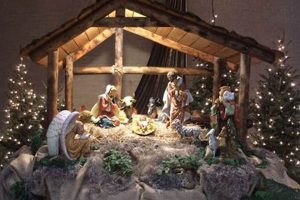The creation of intentionally garish holiday-themed garments, often involving embellishments, modifications, or repurposing of existing sweaters, constitutes a popular seasonal activity. For example, individuals may affix items such as ornaments, tinsel, or battery-operated lights to a pre-existing sweater to achieve the desired aesthetic.
This activity offers a creative outlet and provides a means of personal expression during the holiday season. Engaging in this form of crafting can foster a sense of community, particularly when undertaken in groups. Furthermore, the resulting garments often serve as conversation starters and contribute to festive gatherings. The trend has seen a surge in popularity, evolving from niche parties to widespread participation in holiday celebrations.
The subsequent sections will delve into specific techniques for garment construction, provide guidance on sourcing materials, and offer inspiration for designs. Information regarding cost-effective strategies and safety precautions will also be provided.
Guidance for Garment Construction
The following provides essential guidance for successful sweater modification. Prior planning and careful execution are crucial for achieving the desired outcome.
Tip 1: Material Selection. Prioritize lightweight embellishments to minimize garment weight and prevent distortion. Fabric glue should be selected based on material compatibility.
Tip 2: Secure Attachment. Ensure all embellishments are securely affixed to prevent detachment during wear. Reinforce glued items with stitching where feasible.
Tip 3: Design Planning. Sketch a preliminary design before commencing work. This facilitates a clear vision and reduces errors.
Tip 4: Electrical Safety. When incorporating electronic components, ensure proper insulation and use low-voltage power sources to minimize the risk of electrical hazards.
Tip 5: Size Considerations. Account for the added bulk of embellishments when determining sweater size. Overcrowding can compromise wearability.
Tip 6: Fabric Stability. Consider the sweater’s knit structure and integrity. Heavy embellishments may damage delicate knits. Reinforce the base sweater if needed.
Tip 7: Color Harmony. While aiming for unconventional aesthetics, thoughtful color choices can enhance the overall design. Limit the number of competing hues to avoid visual overload.
Tip 8: Durability Testing. Before wearing, gently test the attachment of all embellishments. Perform a trial run to ensure comfort and mobility.
Adhering to these guidelines will enhance the longevity and aesthetic appeal of the embellished garment. Careful consideration of materials, safety, and design principles are paramount.
The next section will provide details about where to source materials.
1. Creativity
Creativity forms a cornerstone in the creation of intentionally unattractive holiday-themed sweaters. Its application extends beyond mere aesthetic design, influencing material selection, construction techniques, and the overall narrative communicated by the garment.
- Unconventional Material Integration
Creativity dictates the use of materials not typically associated with apparel. This can include household items, repurposed decorations, or discarded objects integrated into the sweater’s design. This often results in a striking visual impact, contributing to the item’s unconventional aesthetic.
- Humorous Narrative Construction
Creative narrative plays a crucial role. The selection of specific embellishments or patterns can create a humorous story or visual pun, enhancing the items engagement factor. Examples include incorporating pop culture references, satirical holiday themes, or self-deprecating humor.
- Adaptive Construction Techniques
Crafting these garments often necessitates unorthodox construction methods. Creative problem-solving is required to securely attach unconventional materials, manage weight distribution, and ensure the structural integrity of the modified sweater. This can involve employing non-traditional adhesives, innovative stitching patterns, or reinforcing techniques.
- Subversion of Holiday Norms
A key aspect lies in the subversion of traditional holiday aesthetics. Creativity facilitates the intentional violation of established design principles, resulting in a visually jarring and unconventional outcome. This may involve clashing colors, disproportionate embellishments, or the deliberate creation of visual dissonance.
In summary, creativity is integral to all facets of the unique holiday garment. It allows for a degree of self-expression that traditional fashion does not usually encourage and provides an opportunity for both the creator and the viewer to explore and challenge accepted conventions related to both fashion and holiday traditions.
2. Embellishment
Embellishment is intrinsically linked to the aesthetic and conceptual nature of deliberately unattractive holiday-themed sweaters. The degree and type of embellishment directly influence the resulting garment’s appearance and its perceived status within this specific style. Without substantial and often intentionally discordant embellishment, a sweater fails to meet the criteria. For example, a plain red sweater with a small, neatly embroidered Christmas tree would not qualify; however, the same sweater adorned with oversized, glued-on plastic ornaments, flashing lights, and copious amounts of tinsel definitively would.
The selection of embellishments also contributes to the overall narrative of the garment. Embellishments can be used to create humorous or ironic effects, referencing popular culture, holiday traditions, or even personal anecdotes. Consider a sweater featuring a tangled string of Christmas lights with a miniature figure of a cat “attacking” it; this conveys a specific narrative and comedic effect. The application of embellishments is not merely decorative but rather integral to communicating the intended message. Further, the act of applying these elements, whether painstakingly hand-stitched or hastily glued, is part of the character and design process.
In summary, embellishment represents a foundational element. The type, quantity, and placement of embellishments are not arbitrary; they are crucial in achieving the desired effect. Understanding the principle helps to craft garments that effectively embody this specific fashion style, allowing for intentional and impactful design choices.
3. Repurposing
Repurposing plays a key role in the creation of intentionally unattractive holiday garments. It entails utilizing pre-existing materials, diverting them from their original purpose and extending their lifespan. This practice contributes to the unique aesthetic and sustainable aspects of this craft.
- Material Diversion
Repurposing encourages the use of unconventional items found in households or thrift stores. Examples include outdated holiday decorations, discarded toys, or fabric scraps. Integrating these materials reduces waste and contributes to the garment’s unique and often outlandish appearance.
- Resourcefulness and Cost Reduction
Utilizing repurposed materials can significantly lower the overall cost of creating the garment. Rather than purchasing new embellishments, individuals can creatively reuse existing items, making the craft more accessible and budget-friendly. For instance, old Christmas cards can be cut into shapes and attached to the sweater.
- Creative Transformation
Repurposing fosters creativity by challenging individuals to reimagine the potential of existing objects. A broken string of lights can be reconfigured into a decorative pattern, or an old scarf can be transformed into a festive trim. This process encourages innovation and unique design solutions.
- Sustainable Practices
Repurposing aligns with principles of sustainability by reducing consumption and waste. It promotes a circular economy model where materials are given a second life instead of being discarded. This aspect appeals to environmentally conscious crafters and contributes to the ethical value of the craft.
The application of repurposed materials serves not only to minimize waste and reduce costs but also to enhance the character of the garment. The incorporation of familiar yet unexpected items amplifies the intended visual statement, solidifying the garment’s unique character within the seasonal craft landscape.
4. Originality
Originality constitutes a critical factor in the landscape of deliberately unattractive holiday sweaters. The essence of these garments lies in their departure from conventional holiday aesthetics, demanding a high degree of inventiveness in design and execution. Without a substantial measure of unique conception, the resulting article risks appearing derivative, undermining its fundamental appeal. For instance, a sweater merely replicating a pre-existing design found online would lack the innovative spirit central to the genre. In contrast, a sweater incorporating uncommon materials or a distinctive narrative would embody originality.
The significance of originality extends beyond aesthetics. It reflects the creator’s individual expression and skill in transforming ordinary materials into a unique, humorous, and festive statement. The perceived value and interest in these garments are directly proportional to their unique attributes. Consider the example of a sweater constructed entirely from repurposed holiday packaging materials, arranged to form a satirical commentary on consumerism. Such a design exhibits a high degree of originality, elevating it beyond a mere replication of established trends. Furthermore, participation in contests typically emphasizes creative interpretation and unique execution as key evaluation criteria.
In summary, originality is not merely an optional enhancement but a foundational requirement. Its presence distinguishes garments from mass-produced alternatives and underscores their value as expressions of individual creativity and unique perspectives on holiday traditions. The continuous pursuit of fresh ideas presents a challenge, requiring constant innovation and a willingness to experiment with unconventional materials and concepts. Ultimately, the embrace of originality ensures the continued evolution and relevance of this particular craft form.
5. Festivity
Festivity serves as the foundational element upon which the deliberately unconventional holiday garment is constructed. It provides the thematic context and dictates the selection of imagery, color palettes, and decorative elements incorporated into the design. Without a discernible connection to the holiday season, the garment loses its relevance and fails to achieve its intended purpose.
- Thematic Representation
Festivity necessitates the inclusion of readily identifiable holiday themes. These may include traditional figures such as Santa Claus, reindeer, snowmen, or Christmas trees. The representation of these themes, however, is often exaggerated, distorted, or presented in unconventional contexts to achieve the intentionally unattractive aesthetic. For instance, a Santa Claus figure might be depicted with disproportionately large features or engaged in an absurd activity.
- Color Palette Adherence
Festivity dictates the use of specific color palettes traditionally associated with the holiday season. These typically include combinations of red, green, white, and gold. The implementation of these colors, however, is frequently executed in a visually jarring or clashing manner, contributing to the overall aesthetic. For example, the garment might feature an excessive use of glitter or neon variations of traditional colors.
- Symbolic Embellishments
Festivity mandates the incorporation of symbolic embellishments that evoke the holiday spirit. These may include ornaments, tinsel, bells, or miniature lights. The application of these embellishments is often excessive and strategically placed to maximize visual impact. The embellishments may be mismatched or seemingly randomly attached, further enhancing the garment’s deliberately unattractive quality.
- Seasonal Narratives
Festivity allows for the representation of seasonal narratives or cultural references related to the holiday season. These may include depictions of holiday traditions, popular songs, or cultural iconography. The narratives are often presented in a humorous or satirical manner, adding to the garment’s overall character. An example would be depicting a chaotic family gathering or a humorous interpretation of a classic holiday song.
The effective integration of festivity ensures that the garment maintains its contextual relevance and effectively communicates its intended message. While deliberately unattractive in design, these garments are, at their core, celebrations of the holiday season and expressions of seasonal cheer.
6. Individuality
The creation of deliberately unattractive holiday garments provides a tangible outlet for individual expression. The genre inherently encourages deviation from established fashion norms and conventional holiday aesthetics, thereby fostering a space for unique design choices. The effect is that each resulting garment functions as a personalized statement, reflecting the creator’s sense of humor, artistic skill, and interpretation of seasonal traditions. This divergence from uniformity explains the prevalence of unique, one-of-a-kind creations within this stylistic category. The importance of individuality in this context cannot be overstated; it constitutes a fundamental characteristic. Without it, the garments risk blending into a generic mass of holiday-themed attire, losing their distinctive appeal. For example, individuals might incorporate personal mementos, inside jokes, or handcrafted elements into their designs, further embedding their unique identity within the garment. This understanding has practical significance for creators, guiding them to prioritize self-expression and creative experimentation when designing and constructing these pieces.
Further analysis reveals that individuality also shapes the reception and interpretation of the garments. Because each piece reflects a unique perspective, viewers often engage with them on a personal level. This can lead to conversations, shared laughter, and a sense of connection among individuals who appreciate the unconventional aesthetic. Consider, for instance, a garment featuring a hand-painted depiction of a family pet dressed in holiday attire; it’s likely to resonate more deeply with individuals who share a similar fondness for animals or who appreciate the personal touch of handmade art. The garments often serve as icebreakers at social gatherings, prompting discussions about the creator’s inspiration, techniques, or personal connection to the holiday season. This social function underscores the practical application of individuality in fostering community and creating memorable experiences.
In conclusion, individuality is not merely a decorative aspect but a defining characteristic. It is a crucial element within the purposefully unattractive holiday garment creation. This emphasis promotes authentic self-expression, encourages unique designs, and enhances the garment’s social value. While navigating the balance between originality and potentially offensive humor presents a recurring challenge, embracing individuality ultimately enriches the tradition and contributes to its continued popularity as a creative outlet during the holiday season.
7. Humor
Humor constitutes a defining characteristic of intentionally unattractive holiday garments. Its presence elevates these creations beyond mere articles of clothing, transforming them into communicative devices. This specific type of humor often relies on irony, satire, and the subversion of established holiday traditions.
- Ironic Juxtaposition
Ironic juxtaposition involves placing incongruous elements together to create a humorous effect. Examples include pairing saccharine holiday imagery with dark humor themes or combining highbrow artistic styles with traditionally lowbrow holiday subjects. This approach generates humor through the unexpected contrast, challenging viewers’ expectations.
- Satirical Commentary
Satirical commentary utilizes the garment as a medium to critique societal norms or holiday-related commercialism. This might involve depicting exaggerated displays of consumerism, lampooning family dynamics, or parodying popular holiday movies. The humor arises from the recognition and understanding of the underlying social critique.
- Visual Puns and Wordplay
Visual puns and wordplay incorporate clever linguistic or visual tricks to create a humorous effect. This might involve depicting literal interpretations of holiday idioms or using images that resemble humorous words or phrases. The humor stems from the cleverness of the pun and the viewer’s ability to decipher its meaning.
- Self-Deprecating Humor
Self-deprecating humor embraces the inherent absurdity of the tradition itself. This might involve creating garments that are intentionally clumsy, poorly constructed, or adorned with outlandish embellishments. The humor arises from the wearer’s willingness to embrace imperfection and poke fun at themselves and the tradition. For instance, intentionally mismatched patterns, lopsided appliques, or overly enthusiastic use of glitter are examples.
The deployment of humor within deliberately unattractive holiday garments serves multiple functions. It facilitates social interaction, promotes lightheartedness, and provides a channel for expressing individual creativity. The effectiveness relies on the successful integration of these facets, resulting in a humorous commentary that resonates with both the wearer and the observer.
Frequently Asked Questions
The following addresses common inquiries regarding the construction and aesthetic principles of intentionally unattractive holiday garments.
Question 1: What constitutes a deliberately unattractive holiday garment?
It typically involves a sweater, often embellished with incongruous, excessive, or unconventional decorative elements associated with the holiday season. The objective is to create a visually jarring or humorous effect.
Question 2: Are there specific materials to avoid when crafting such a garment?
While there are no strict prohibitions, delicate materials prone to damage from adhesives or heavy embellishments should be avoided. Similarly, materials posing safety risks, such as sharp objects or flammable substances, should be excluded.
Question 3: How can originality be ensured in design?
Originality can be achieved through unconventional material combinations, unique thematic interpretations, and the incorporation of personal narratives or inside jokes.
Question 4: Is there a limit to the number of embellishments one can apply?
While excess is often encouraged, practicality must be considered. The garment must remain wearable and not pose a hazard to the wearer or others.
Question 5: How important is adherence to traditional holiday colors?
While traditional holiday colors often form the foundation, deliberately clashing or unconventional color combinations are frequently employed to enhance the deliberately unattractive aesthetic.
Question 6: What safety precautions should be observed when crafting these garments?
Adhesives should be used in well-ventilated areas, and electrical components must be properly insulated. Sewing needles should be handled with care, and embellishments should be securely attached to prevent detachment and potential choking hazards.
Careful consideration of materials, design principles, and safety precautions contributes to the successful construction of a deliberately unattractive holiday garment.
The subsequent section will cover the environmental impact of this kind of seasonal craft.
Conclusion
This exploration of “ugly christmas sweaters diy” has illuminated several facets, from creative techniques and material sourcing to the underlying principles of originality, festivity, and humor. Garment construction involves deliberate embellishment, often relying on repurposing to minimize cost and waste. The practice allows for individual expression and encourages participation in seasonal festivities.
As individuals engage in the construction of these garments, responsible sourcing of materials and thoughtful design choices that promote sustainability should be considered. The garments represent creative outlets, and conscious effort can ensure that the engagement results in a reduced environmental impact.







